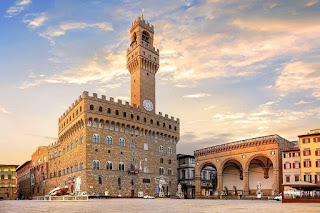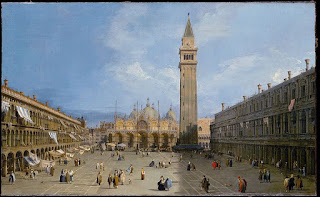Just as the title suggests, the premise in this book pertains to Dante Alighieri's Divine Comedy, specifically his portion on hell (referred to as Inferno). I own this classic work of literature and have made several attempts to read the poetic story. The general premise of the Divine Comedy regards to the poet Dante's journey into hell, purgatory, and heaven. The book is loaded with poetic allegories and historical references. I intend to once again read this book thru and later break down his philosophical construction of the afterlife in another post. However for now I revert back to the inspiration provided by Dan Brown's modern day thriller.
The Synopsis
The famous Harvard professor of art history, Robert Langdon is once again called upon to aid in a great mystery. At the start of the book he awakes in a Florentine hospital, delirious and experiencing a heavy bout of amnesia. His nurse Sienna Brooks, begins asking him questions and informs him that he was shot in the head Robert struggles to remember anything and has sharp flashes of satanic images. Like most Dan Brown books, it does not take long for the drama to begin. Before Robert can even come to terms with why he is in the hospital he is being hunted and chased by an assassin name Vaynetha. Sienna helps Robert Langdon escape the hospital and they are soon fleeing from an enemy they do not even know.
Sienna takes Robert to her apartment, where they have some time to formulate a plan. Robert is provided new clothes, and continues to see visions of demons and an old lady telling him to "Seek and Find". Robert and Sienna later discover a mini projector in his jacket pocket that displays Sandro Botticelli's painting of the Map of Hell. Robert is familiar with the painting as the most detailed visualization of Dante's description of Inferno. Robert however quickly notices some irregularities in the painting and he and Sienna are able to decipher a hidden message in the painting, "Cerca Trova". Langdon quickly realizes that this is a reference to Giorgio Vasari's famous painting, The Battle of Marciano.Like in most Dan Brown books, he gives a simultaneous perspective from the villains as the drama unfolds. A secret organization known as the Consortium is working against Langdon to protect the privacy of their client, Bertrand Zobrist. It is later revealed that Zobrist is a mad scientist who believes the world is at the brink of overpopulation and has thus hidden a deadly plague before his recent suicide. The World Health Organization has also been made aware of this major threat and enlists Robert Langdon to help them decipher the trail of clues Zobrist has left. All of the clues are references to Dante's Inferno and the Black Death plague.
Just as Robert realizes why he is in Florence, he and Sienna are once again on the run from the Consortium's agents. They are also being chased by a separate branch of WHO agents, under the direction of Dr. Elizabeth Sinskey (who enlisted Robert before his blackout). Despite the heightened police and security, Robert and Sienna are able to make it inside the famous Florentine museum known as the Palazzo Vecchio (with it's iconic tower). Robert is fortunate to bump into the museum's head curator, Marta Alvarez and requests that they see the death mask of Dante. Marta reminds Langdon that he and the director of the Florence Cathedral Ignazio Busoni, had just visited last night to see the mask. At this point Marta realizes that the mask has been kidnapped and Robert is the clear culprit.Robert and Sienna are held in the security room of the museum, where everyone is shocked to see video footage of Robert and Iganzio stealing the mask. Robert has no recollection of this and tries to calm everyone down, however their situation is further intensified as the police forces storm the museum. Within the security room, Robert is given a message that Ignazio has died and left him a message regarding the mask and "Paradise 25". Robert and Sienna are able to take advantage of the ensuing police invasion to escape the security room and flee up into the rafters of the museum. Here they are chased by the assassin, Vayentha who is sent falling from the rafters, thru the ceiling paintings, and onto the floor of the Hall of the 500 where she meets her death.
Robert and Sienna are able to escape the Palacia and make their way to the Florence Cathedral, also known as Il Duomo (for it's iconic large orange dome). They are able to decipher Ignazio's clue as a verse within Dante's Paradise, pertaining to a baptistry within the golden gates. Robert realizes this is a reference to the famous Florence Baptistry in front of the Florence Cathedral. Here they are able to find the stolen death mask of Dante, and later realize there is a hidden message behind the mask. This is a long message from Zobrist, with an allegorical description of the plague he has released. At this point Robert and Sienna are joined by a mysterious person named Jon Ferris (who claims to be working with the WHO but is rather a secret agent of the Consortium). The three of them reason that their next clue is located in the city of Venice and arrange a train ride there.Meanwhile at the Consortium headquarters, their director (known as the Provost), begins to question their client Zobrist. He watches a disturbing video of Zobrist explaining the current crisis of overpopulation and how he has chosen to take matters into his own hand by releasing this plague. At this point the Provost decides to break his protocol, and reaches out to the government agency of the WHO to stop this threat. Together both organizations realize that Robert is headed to Venice and chase him there to Saint Marco's Basilica.
Within the Basilica, Robert, Sienna, and Ferris continue to unlock Zobrist's riddle on the mask referring to severed horse heads, tombs, and chthonic monsters. Robert is eventually able to reason that they are after a doge named Enrico Dandolo, whose tomb is not located in Venice but in the city of Istanbul at the Hagia Sophia. However before they can redirect to Istanbul, Ferris collapses from chest pain, and Robert and Sienna are chased once again by the Italian authorities. This time however Sienna is able to escape while Robert is captured. At this point it is revealed that Sienna was the lover and follower of Zobrist, and she was working to ensure the plague was released.Robert is brought up to speed by Dr. Sinskey, who informs him that she brought him to Florence to help uncover Zobrist's diabolical scheme. The situation got even more complicated however when the Consortium interfered with Sinskey, and staged an elaborate scheme to trick Robert into helping them locate the plague. It is also revealed that Sienna herself was acting and working with the Consortium to protect Zobrist's plague. However after the Consortium changed it's position in defending Zobrist's wishes, Sienna went rogue to find it. So ultimately Langdon was helping 3 different organizations (the WHO, the Consortium, and Sienna) locate Zobrist's plague.
Robert is then escorted by both the WHO and the Consortium to locate the plague which he believes to be hidden within Enrico Dandolo's tomb at the Hagia Sophia. Once they arrive at the monumental temple, as instructed per Zobrist, Langdon listen's to the dripping water under the tomb. At this point the curator informs them the water channels underground to the Basilica Cistern. He also informs them that the underground dungeon is a tourist attraction and there is a concert there tonight. Dr. Sinskey realizes that this enclosed location is the perfect place to release a plague. So they rush to the underground cistern in search of Zobrist's plastic bag containing the plague.After some searching thru the columns, boardwalks, and sewage water they locate the bag near a statue of Medusa. To their shocking surprise they realize the plague has been released 7 days ago, and at this point it has already become global. Robert notices Sienna is also in the cistern and he chases her out and thru the streets of Istanbul. She later stops running and tells him that she is very conflicted. While she loved and supported Zobrist's ideas, she not did not support a global pandemic. She then reveals the details of the plague, which is not a deadly plague yet rather an infertile plague. Robert then guides her to work with Dr. Sinskey to help address and contain the plague.
In a rather unusual twist, Dr. Sinskey seems to support Zobrist's plague which intends to affect only one third of the population. She realizes that this sharp reduction in birth rates will help stabilize the population for the foreseeable future. She agrees to work with Sienna to better understand and explain her reasoning to WHO and the rest of the world. Sienna and Robert share a final goodbye and it is clearly implied that they have developed strong feelings for one another. The next day Robert returns the death mask to the Palazzo Vecchio and attends the funeral of his friend Iganzio. He then happily leaves Florence and returns to his home in Massachusetts.
Book Review
As usual Dan Brown succeeded in this book, by creating an exhilarating page turner. He provides the same format he did in the previous Langdon books with a thrilling mystery surrounded by historical art. Professor Langdon is as cool as he is knowledgeable on all things related to historical art. What I especially love about this series is not only the dramatic flow of the story yet the subtle historical insight that is provided. This time Dan Brown offered some great academic insight revolving around Dante's famous work of literature, the Divine Comedy. A topic that has always intrigued me, and has recently inspired me to read the classic work again.
Unlike the other of Brown books containing incredible insight to secret societies such as the Opus Dei, the Illumaniti, the Knights Templaer, or the Freemasons, that was not the case in this book. Instead the villain Zobrist was mostly a lone wolf with a cult-like following. His theories of overpopulation and transhumanism were very interesting and perhaps the biggest take away from this book (aside from the academic details of Dante and Italy). I found it very interesting to see his points and graphs regarding the sharp incline in population and the decline of resources. This is no doubt a political topic, however often seems to shift to the more fanatical conspirators.
As I mentioned in the intro I still very much enjoyed this book, and zipped thru it as I did all previous Dan Brown books. However ultimately I just did not feel as captivated as I did by the other books. I felt the scheming organizations to be a little complicated and messy at the end. I especially didn't like the reveal that everything was staged to push Langdon into locating the plague. Furthermore, the fact that the villain gets his way in the end also leaves a sour taste (even if his plague made logical sense, it was still a crime). Ultimately I'll still say that the book was enjoyable and I would recommend it for anyone who enjoys history, culture, and art.








No comments:
Post a Comment